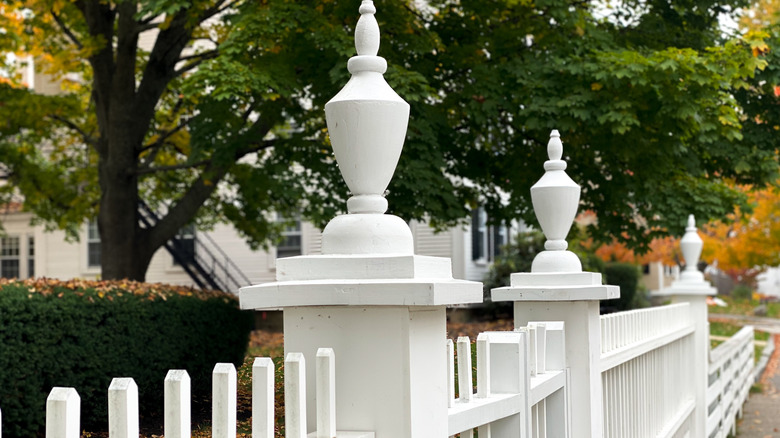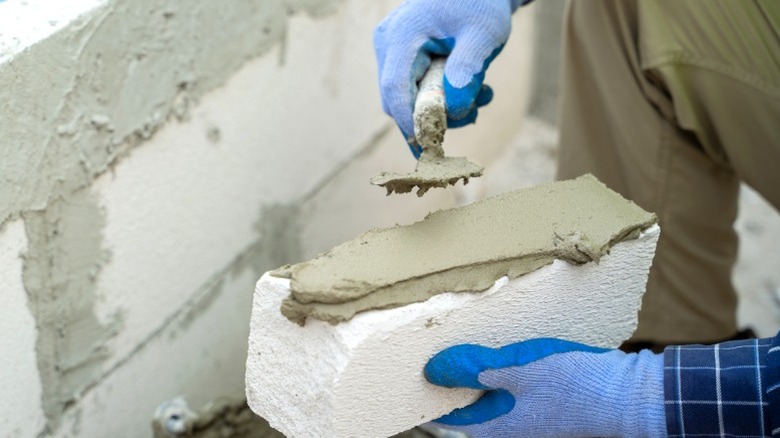Give Your Fence An Upgrade With A Simple Cinderblock DIY That Looks Custom Built
Is your front fence starting to look blah and boring? Creating a custom look with this DIY project can take it from frumpy to fabulous. Although this is an ambitious project, you can do it with some perseverance, basic tools, and careful planning. It'll spruce up almost any type of fence and deliver a big-time boost to your home's curb appeal. This planter fence base is a simple design. At each end of the fence, place a cinderblock perpendicular to the fence, and then place a row of cinderblocks parallel to the fence between them. If at all possible, adjust the spacing so that you don't have to cut any cinderblocks.
This is one of those projects where most of the work is upfront in the prep phase. This may be fairly easy if your yard is level. Otherwise, you might have to do some digging. Clear the area in front of the fence and put down a layer of gravel base where the cinderblocks will go. Tamp down the gravel base with a tamping tool, and set the first perpendicular cinderblock on it. Put the next cinderblock in place, and set a level over both blocks to make sure they're even. If it's off, tamp down the ground some more, dig out some more dirt, or add more base gravel. When you have a good fit, apply landscape adhesive to the sides and press them together. Repeat the process until all of the cinderblocks are in place.
How to DIY a cinderblock fence base
After you have the cinderblocks in place and the glue is completely set, cover them with surface-bonding cement to fill the joints and create a smooth finish. Start by wetting the front of several blocks. Mix the cement according to the directions, only preparing as much as you'll use in about 10 minutes. Place a piece of cardboard at the base of the block to protect your grass from cement drips. Use a trowel to apply the surface-bonding cement evenly to the cinderblocks, paying special attention to the joints. Continue wetting the blocks and applying the cement until you reach the end.
To finish off the cinderblock planters, you'll apply thin brick singles to the top. To get the spacing right, place a brick at the outside edge of the first perpendicular block, leaving a slight overhang. This brick should be perpendicular to the fence. You'll have an empty space between the back of the brick and the fence. Cover this by placing several bricks parallel to the fence. Attach the bricks to the top of the cinderblocks with landscape adhesive, leaving a gap of ⅜ of an inch between each brick. You can make this easy by creating a cardboard spacer to put between the bricks as you set them. Put premixed mortar between the bricks using a long, thin painting knife, wiping off any excess as you go. Complete the look by filling the space between the cinderblock base and the fence with dynamic flower and plant combinations in containers.
Pitfalls to avoid when making your cinderblock fence base
This is a fairly forgiving DIY project, but you should be aware of some issues that could give you problems. The biggest pitfall you may run into is uneven ground. If your cinderblocks aren't level, the bricks won't be either, and your planter will look crooked and unprofessional. Using a level as you go will help you avoid this. Each block may need to be individually adjusted a little higher or lower, even if your ground looks even.
Another thing to watch for is making sure your blocks are wet while you're applying the surface-bonding cement. If it dries out too quickly, the finished concrete surface will crack. Apply the cement with short strokes from the ground up for best results. If you want a smoother surface, go over it with a second clean trowel. When you're mortaring the bricks, avoid smearing mortar on the surface since it can be difficult to clean off. If you're worried about shaky hands, you can tape off the bricks with painter's tape to keep them clean.
Don't feel like you have to stick with bricks for the top of your planter. You can use any type of retaining wall cap that suits your style. Flat, concrete blocks are a simple option. Natural stone, such as granite or limestone, can give your fence an old-world look. Depending on the look you want, you can either use adhesive or mortar to attach the caps. It may take a while, but creating a cinderblock planter is a gorgeous way to style a picket fence.

